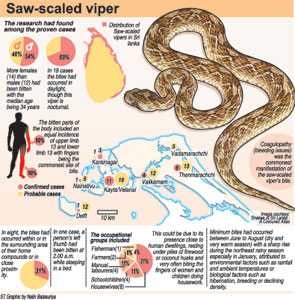The not much talked of saw-scaled viper is the No. 1 biter in the Jaffna peninsula among the deadliest venomous five in Sri Lanka, with the more feared Russell’s viper and cobra coming second and third.
This has been revealed by a long overdue research conducted at the Jaffna Teaching Hospital by an eminent team, as soon as the war-ravaged peninsula became accessible with the end of the conflict.
The unexpected confrontations with the saw-scaled viper (Echis carinatus) are many, leaving many unsuspicious women and children going about household chores, the victims, the research which has been published in Elsevier by the Royal Society of Tropical Medicine & Hygiene, has found.
Titled ‘Revisiting saw-scaled viper bites in the Jaffna peninsula of Sri Lanka: Distribution, epidemiology and clinical manifestations’, the research has been carried out by Prof. S.A.M. Kularatne and Dr. S.C. Medagedera both of the Peradeniya Medical Faculty’s Department of Medicine; Dr. S. Sivansuthan of the Jaffna Teaching Hospital; Dr. K. Maduwage of the Peradeniya Medical Faculty’s Department of Biochemistry and Anslem de Silva, herpetologist and well-known “snakeman”.
Venomous snake bites in the Jaffna peninsula, foremost of which are saw-scaled viper bites, have been an issue lying dormant and swept under the undergrowth but has now been brought to light.
This study is of major significance because it is the first comprehensive one with voucher specimens of the venomous snake, the Sunday Times understands.
The study of a total of 304 patients admitted to the Jaffna Hospital with a history of snake-bite from February 2009 to January 2010, fills the information lacuna on saw-scaled viper bites after P.E.P Deraniyagala’s ‘A coloured atlas of some vertebrates from Ceylon’ published as way back as 1955.
The research spanning Jaffna Hospital and Peradeniya University miles away, had been designed to “evaluate the true burden, effects of envenoming, distribution and epidemiology” of the bites of the saw-scaled viper known as “vali polonga” in Sinhala and “suratti pamba” in Tamil.
Of the total number, 217 (71%) patients had been bitten by venomous species or envenomed by unidentified snakes. Among the identified species, 99 (46%) were saw-scaled viper bites while the balance included 42 Russell’s viper (D. russelii), 6 cobra (N. naja) and 10 common krait (B. caeruleus) bites, according to the study. (see graphic above)
Interesting details emerge from the research which had also studied the 26 saw-scaled vipers (21 dead and five alive) brought by the bite-victims. The median length of the snakes, comprising both male and female, had been 260mm. Examination of mouth parts had found unbroken folded front fangs measuring 3-5 mm in length. The body surface of the vipers had been serrated and the live snakes had coiled into a double fold and rubbed the lateral aspects of their bodies continuously producing a characteristic shrill sound.
They had attacked with lightning speed at the slightest provocation, darting about two-third of their body length and then returned to the original posture, the study states.
With the saw-scaled viper usually inhabiting dry and coastal plains near the sea, the majority of the bite victims from the Jaffna peninsula had been from the Kayts/Velanai islets, while no cases had come in from the south of Chavakachcheri down to Kilinochchi. The reason attributed by the study is that “these areas were uninhabited for many years due to the military occupation from 2001”. However, security forces personnel in the Jaffna peninsula (Elephant Pass isthmus) had reported seeing saw-scaled vipers among the debris and had frequent encounters at night, it states.
The bite victims were mostly people living in ill-constructed houses surrounded by sandy and low grown shrubs, piles of coconut husks or palmyrah leaves near the compounds. Careless human activities were the probable major contributory factors for bites, it has been found.
Meanwhile, the study also brought out the fact that most victims had sought hospital treatment within hours of the bite, the majority had washed the bitten site with water while some had applied a tourniquet. The possible impact of tourniquets on increasing the severity of the local effect at the bite-site should be investigated, the study urges.
Another important factor disclosed in the study is that though the Indian polyvalent anti-venom seemed to be effective in reversing the coagulation defect (the clinical picture of the bite victims had been dominated by incoagulable blood and occasional situations of spontaneous bleeding from mucus membranes), its action was slow in onset and incomplete in reversing the clotting defect.
Battling the poison
The priority is the development of effective and less allergenic anti-venom against all Sri Lankan venomous snakes including the saw-scaled viper, stresses the research team, as a failure in efficacy of the Indian polyvalent anti-venom has been indicated in saw-scaled viper bites.
When resettling the displaced, the team requests not only government agencies but also non-governmental organizations to make people aware about the saw-scaled viper and how to avoid coming into contact with it. “They should be advised against killing these snakes as their venom is a valuable medical and scientific tool,” a team member said.
It is also vital to have adequate stocks of anti-venin serum in northern hospitals, he said, commending the immense support extended by the Jaffna Hospital authorities and also security forces personnel when conducting the research.
Pointing out that the Sri Lankan saw-scaled viper is smaller than the Indian saw-scaled vipers especially E. sochureki which cause severe envenoming and death, the team urges that more research should be carried out to ascertain why the Lankan snake is only causing non-fatal envenoming. |


